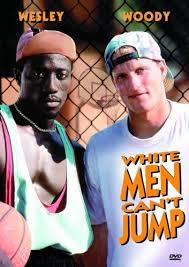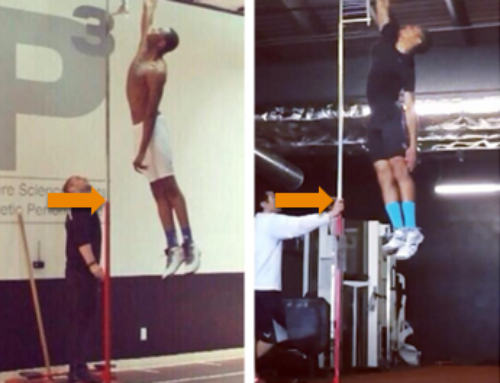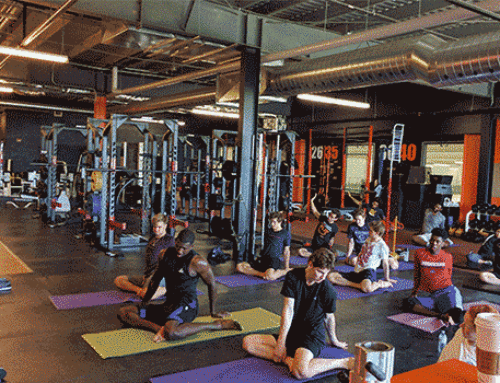Does jumping like Vince Carter, Michael Jordan, Aaron Gordan or the reigning two-time defending dunk Champion Zach Lavine matter for a hockey player? The simple answer is YES.

Photo Credit: JOHN SWART/AP; JESSE D. GARRABRANT/GETTY IMAGES; AP; ELSA/GETTY
There have been numerous studies that directly show vertical jump is directly related to skating speed, skating agility, skating acceleration[1-5] and even hockey performance in the NHL[6], NCAA[1, 7], KHL[8], Czech ELH[8], women’s IIHF[4, 9]. In fact, Burr et al (2008)[6] has shown vertical jump taken during the NHL combine is predictive of NHL Entry Draft Selection position. Or in other words the higher you jump the higher the draft position, irrespective of skill and scouting. This finding is not unlike the NFL Combine, which places a huge emphasis on vertical jump power on draft decisions.
So what can a typical professional athlete jump? A typical NBA basketball player will jump 28 inches, the average for a NHL hockey player is 25 inches, an NFL defensive lineman will jump 30 inches, a skilled position player in the NFL (WR / DB) will jump 38 inches, and a typical female collegiate NCAA Division basketball player will jump 22 inches.
During the 2015/16 season a GTHL AAA hockey team tested at FITS during their training camp in August. The average vertical was 22.4” with a high vertical of 24.8”.
Here are some notable vertical jumps in hockey (coming shortly)
It should be clear, the higher you jump the faster your will be. Of course there are many factors that impact hockey performance in addition to speed. But speed kills. According to Dean Bennett from the National Post regarding Connor McDavid, “McDavid was just one of many great forwards on his team, but it was those moments of acceleration that stood out. A moment’s hesitation, and then he was on top of an opponent and then he was past him. You couldn’t figure out how he did it. It was like he had unlocked a video game cheat code for speed burst.”
The secret is not really a secret, according to a group of researchers and strength and conditioning coaches whose study indicate that the main differentiator of hockey performance is “rate of force production.” The more force you produce the higher you jump. The higher you jump the faster you are on the ice. It’s that simple.

So you may be wondering or heard that “White Men Can’t Jump”. Well that is completely untrue. At FITS we’ve been working with elite alpine ski racers and the average vertical jump of the Men’s Provincial Team (Ontario Ski Team) is 33.5” which is greater than the best jumper on the Canadian Senior Men’s Basketball team – Andrew Wiggins. Yes, a group of 16 – 17-year-old athletes bested an NBA Phenom at his game. Likewise, we’ve produced several 30+ verticals since we’ve moved to Scotiabank Pond and started to work more with hockey players. Some notable results are Graham Knott who jumped 32.3” (selected 54 overall in the 2015 NHL Draft to the Chicago Blackhawks), and Cameron Morrison of the Youngstown Phantoms of the USHL jumped 29” (currently the leads the USHL Rookies in scoring and ranks 5th overall). These athletes are amongst many, training to develop their vertical at FITS and training centres around the world.
If you’re around Scotiabank Pond during the OHL Cup, be sure to drop by and have test your vertical. Leaders win a prize, but more importantly you’ll be able to see where you rank compared to the “BEST”. Just remember your number is just the beginning. How you jumped, how you developed your power, and did you control your body are just as important.
In the next blog, I’ll share some tips on how to enhance your vertical – the answers will likely surprise you.
- Peterson, B.J., et al., Division I Hockey Players Generate More Power Than Division III Players During on- and Off-Ice Performance Tests. J Strength Cond Res, 2015. 29(5): p. 1191-6.
- Runner, A.R., et al., PREDICTORS OF SPEED USING OFF-ICE MEASURES OF COLLEGE HOCKEY PLAYERS. J Strength Cond Res, 2015.
- Janot, J.M., N.M. Beltz, and L.D. Dalleck, Multiple Off-Ice Performance Variables Predict On-Ice Skating Performance in Male and Female Division III Ice Hockey Players. J Sports Sci Med, 2015. 14(3): p. 522-9.
- Ransdell, L.B., T.M. Murray, and Y. Gao, Off-ice fitness of elite female ice hockey players by team success, age, and player position. J Strength Cond Res, 2013. 27(4): p. 875-84.
- Mascaro, T., B.L. Seaver, and L. Swanson, Prediction of skating speed with off-ice testing in professional hockey players. J Orthop Sports Phys Ther, 1992. 15(2): p. 92-8.
- Burr, J.F., et al., Relationship of physical fitness test results and hockey playing potential in elite-level ice hockey players. J Strength Cond Res, 2008. 22(5): p. 1535-43.
- Peterson, B.J., et al., Off-Ice Anaerobic Power does not Predict On-Ice Repeated Shift Performance in Hockey. J Strength Cond Res, 2016.
- Kutáč, P. and M. Sigmund, A Comparison of Somatic Variables of Elite Ice Hockey Players from the Czech ELH and Russian KHL. J Hum Kinet, 2015. 45: p. 187-95.
- Ransdell, L.B., T. Murray, and Y. Gao, Off-Ice Fitness of Elite Female Ice Hockey Players by Team Success, Age, and Player Position. J Strength Cond Res, 2012.




